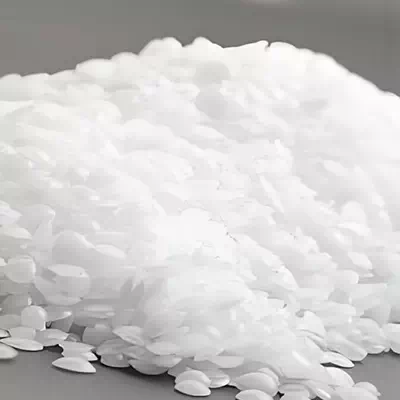

Deshang Chemical directly supplies 52#-70# fully refined paraffin wax (CAS 8002-74-2), oil content ≤0.5%, FDA/Kosher certified, supports customized granule/block form
Paraffin is a hydrocarbon mixture extracted from certain distillates of petroleum, shale oil or other asphalt mineral oils. Its main component is solid alkanes, which are odorless and tasteless, and are white or light yellow translucent solids. Paraffin is a mixture of normal chain saturated alkanes of different molecular weights, which can be represented by the general formula CnH2n+2. According to the physical state of paraffin, it can be divided into three categories: liquid paraffin, solid paraffin and microcrystalline wax. Paraffin has many advantages such as low price, wide source, colorless and tasteless, stable physical and chemical properties, and large phase change latent heat. Therefore, it is widely used in medicine, packaging, construction, military camouflage, industry and agriculture. In recent years, there have been many studies on composite phase change energy storage materials.
Appearance is white solid. Melting point 50℃~70℃, relative density 0.9, average carbon chain length C28~C29, relative average molecular weight 400 varieties: 20℃ solid relative density 0.88~0.93, refractive index 1.526~1.535, 100℃ liquid relative density 0.73~0.77, refractive index 1.418~1.433. Soluble in benzene, chloroform, carbon tetrachloride, camphor oil, insoluble in methanol, ethanol and water.
Paraffin is a mixture of hydrocarbons, so it does not have a strict melting point like a pure compound. The so-called melting point of paraffin refers to the temperature at which the first stagnation period appears on the cooling curve of the melted paraffin sample under specified conditions. Various wax products require paraffin to have good temperature resistance, that is, it does not melt or soften and deform at a specific temperature. According to the differences in use conditions, regions and seasons of use, and use environments, commercial paraffin is required to have a series of different melting points. The main factor affecting the melting point of paraffin is the weight of the selected raw material fraction. The melting point of paraffin extracted from the heavier fraction is higher. In addition, the oil content also has a great influence on the melting point of paraffin. The more oil in the paraffin, the lower its melting point.
Oil content refers to the amount of low-melting-point hydrocarbons contained in paraffin. Too high oil content will affect the color and storage stability of paraffin, and will also reduce its hardness. Therefore, the oil-containing wax paste removed from the vacuum fraction needs to be deoiled by sweating or solvent method to reduce its oil content. However, most paraffin products need to contain a small amount of oil, which is beneficial to improving the gloss and demoulding performance of the products.
During the molding or coating process, paraffin products are in a hot melt state for a long time and are in contact with air. If the stability is not good, it is easy to oxidize and deteriorate, darken the color, and even emit a bad smell. In addition, paraffin will turn yellow when exposed to light during use. Therefore, paraffin is required to have good thermal stability, oxidation stability and light stability. The main factors affecting the stability of paraffin are the trace amounts of non-hydrocarbon compounds and polycyclic aromatic hydrocarbons it contains. In order to improve the stability of paraffin, it is necessary to deeply refine the paraffin to remove these impurities.
| Index | Fully refined paraffin wax | Semi-refined paraffin wax |
| Model range | 52#-70# | 50#-68# |
| Oil content | ≤0.5% | ≤1.8% |
| Chroma (Saybolt) | +30 | +28 |
| Needle penetration (25℃) | 15-20 | 18-25 |
| Morphology selection | Block/Flake/Particle | Block/plate |
Food packaging: wax-coated paperboard moisture-proof performance increased by 40%, passed FDA food contact material certification
Candle manufacturing: high melting point models (58#-62#) reduce demoulding cracking and increase the yield by 25%
Rubber industry: as a softener to reduce the viscosity of rubber, mixing efficiency increased by 30%
Cosmetics: microcrystalline wax (matching supply) improves lipstick molding stability
That is, separating wax from waxy oil. If cold pressing dewaxing or solvent dewaxing is used, oil-containing paraffin can be obtained, and liquid wax can be obtained by molecular sieve or urea dewaxing.
The oil-containing wax can be treated by sweating or solvent deoiling to remove the oil in the paraffin.
The deoiled paraffin is refined with white clay to obtain white paraffin.
The high-melting point paraffin is processed into block products through a molding machine.
1. Direct incorporation method. Add paraffin directly to the substrate. This method is easy to control the amount of addition, but it is prone to phase separation.
2. Immersion absorption method. Use a porous substrate to absorb paraffin for encapsulation.
3. Container encapsulation. It is divided into macro encapsulation and micro encapsulation.
1. Application in the packaging field. Paraffin wax can improve the finish, toughness and printing quality of packaging materials, while reducing production costs. Therefore, it is often used as a papermaking sizing agent and waterproof and oil-proof coating.
2. Application in the industrial and agricultural fields. Paraffin wax is widely used in industrial fields such as rubber, textiles, investment casting, plastics and electronics. It can be used as an antioxidant, softener, toughening agent and release agent for rubber, and can also be used as a gloss finishing agent, softener, batik anti-dyeing agent and water-repellent embedding agent for textiles.
3. Application in the medical field. Liquid paraffin is the most widely used in the medical field. Liquid paraffin is an oily organic substance with strong cohesion. It is insoluble in water and cannot be saponified. It has the characteristics of good transparency, easy flow, no biological toxicity, and similar performance to biological glue.
4. Application in the construction field. Among building materials, phase change paraffin is mainly used in phase change energy storage gypsum board, phase change energy storage concrete, building thermal insulation materials, phase change energy storage mortar and phase change heat storage floor and ceiling, etc.
5. Application in the field of military camouflage. The characteristics of paraffin phase change materials have broad application prospects in thermal infrared camouflage and thermal infrared false targets.
White, hard block at room temperature. Translucent. Wax turns yellow under ultraviolet light. Crystalline. Almost tasteless and odorless. Slippery. Soluble in ether, petroleum ether, benzene and volatile oil, insoluble in water and ethanol, slightly soluble in anhydrous ethanol. Relative density 0.88~0.915, flammable.
White, hard block at room temperature. Translucent. Wax turns yellow under ultraviolet light. Crystalline. Almost tasteless and odorless. Slippery. Soluble in ether, petroleum ether, benzene and volatile oil, insoluble in water and ethanol, slightly soluble in anhydrous ethanol. Relative density 0.88~0.915, flammable.
1. Who are we?
We are headquartered in Shandong Province, China, and we sell to domestic market (45.00%), Western Europe (10.00%), East Asia (10.00%), North America (10.00%), Africa (5.00%), Central America (5.00%), Southeast Asia (5.00%), South America (5.00%), Middle East (5.00%) from 2020. There are 51-100 people in total in our office.
2. How do we ensure quality?
You can get free samples for some products,only need to pay the shipping cost .
We have our own quality control department will provides quality control reports before shipment.
We can accept third party inspection.
3. What can you buy from us?
You can buy organic intermediates, daily chemicals, chemical reagents, inorganic chemicals, pharmaceutical intermediates, APIs and other products you need from me.
4. Why buy from us?
We have high-quality products, professional team, perfect logistics, high-quality service, strong after-sales guarantee
5. What kind of cooperation can we accept?
Acceptable delivery terms: FOB, CFR, CIF, EXW, FAS, CIP, CPT, DDU, express delivery;
Accepted payment currencies: USD, EUR, RMB;
Accepted payment methods: T/T, L/C, D/P D/A, Western Union, cash;
Used languages: English, Russian, Chinese.
Sales hotline:

 Scan and consult wechat customer service
Scan and consult wechat customer service